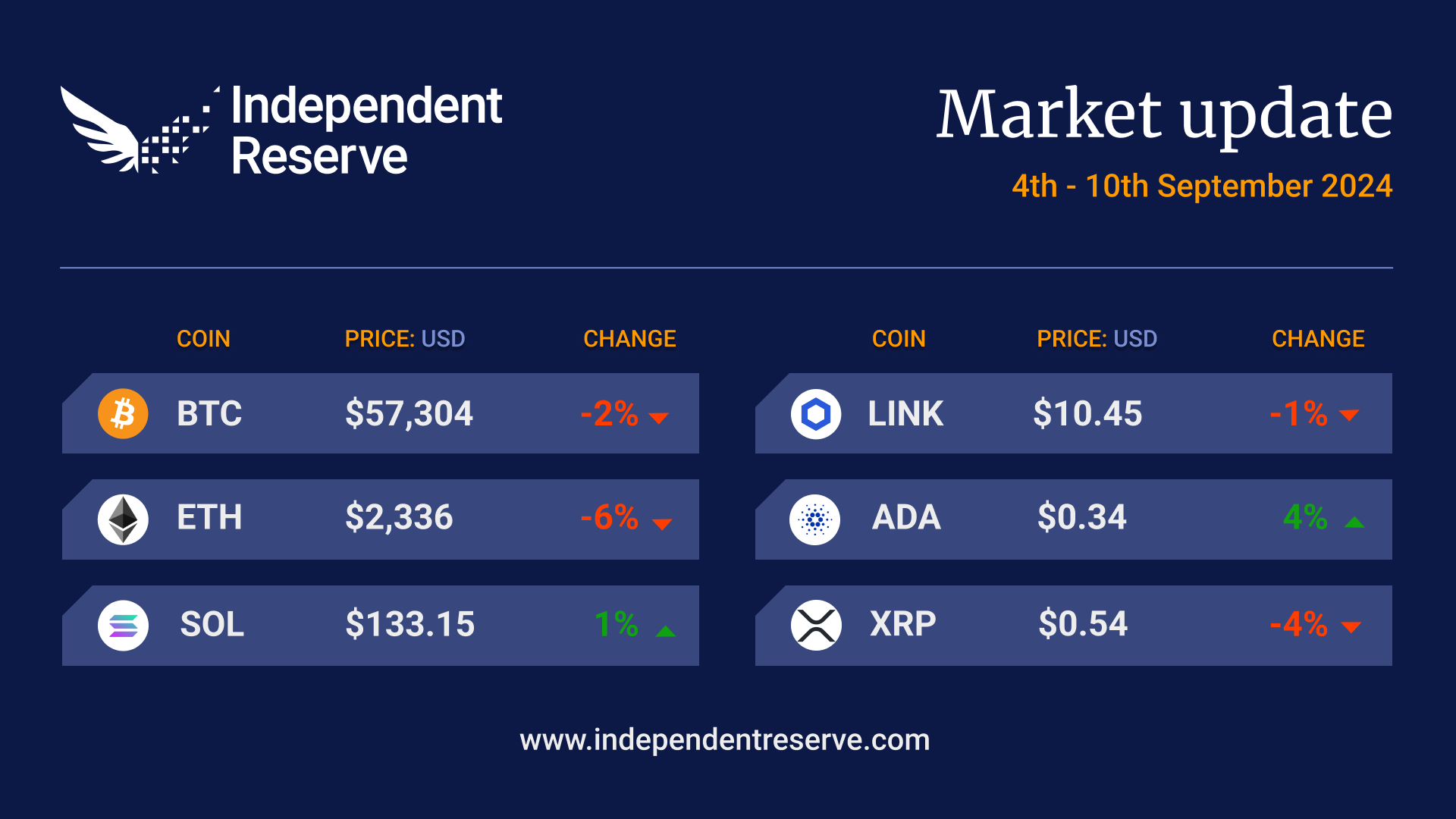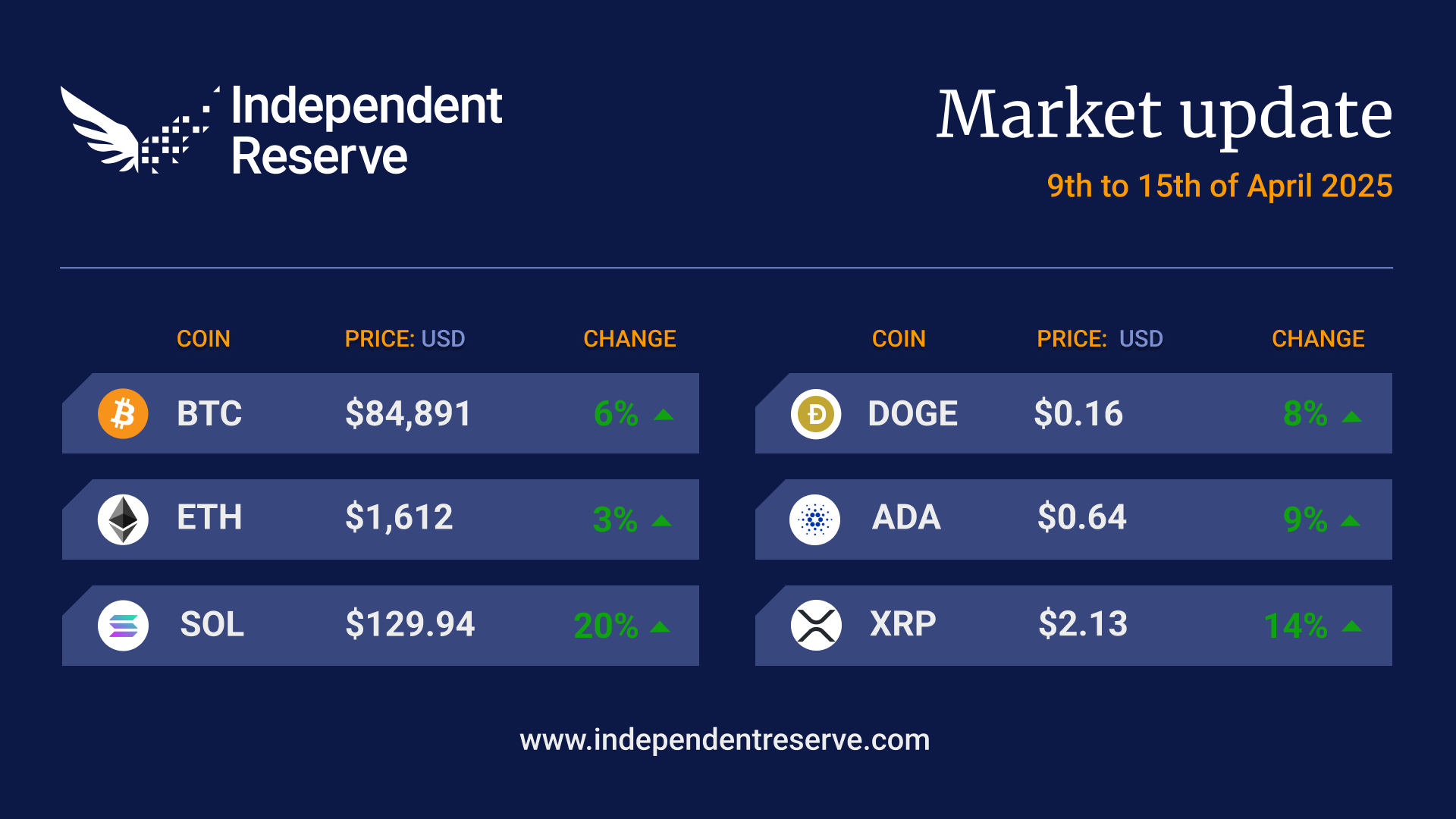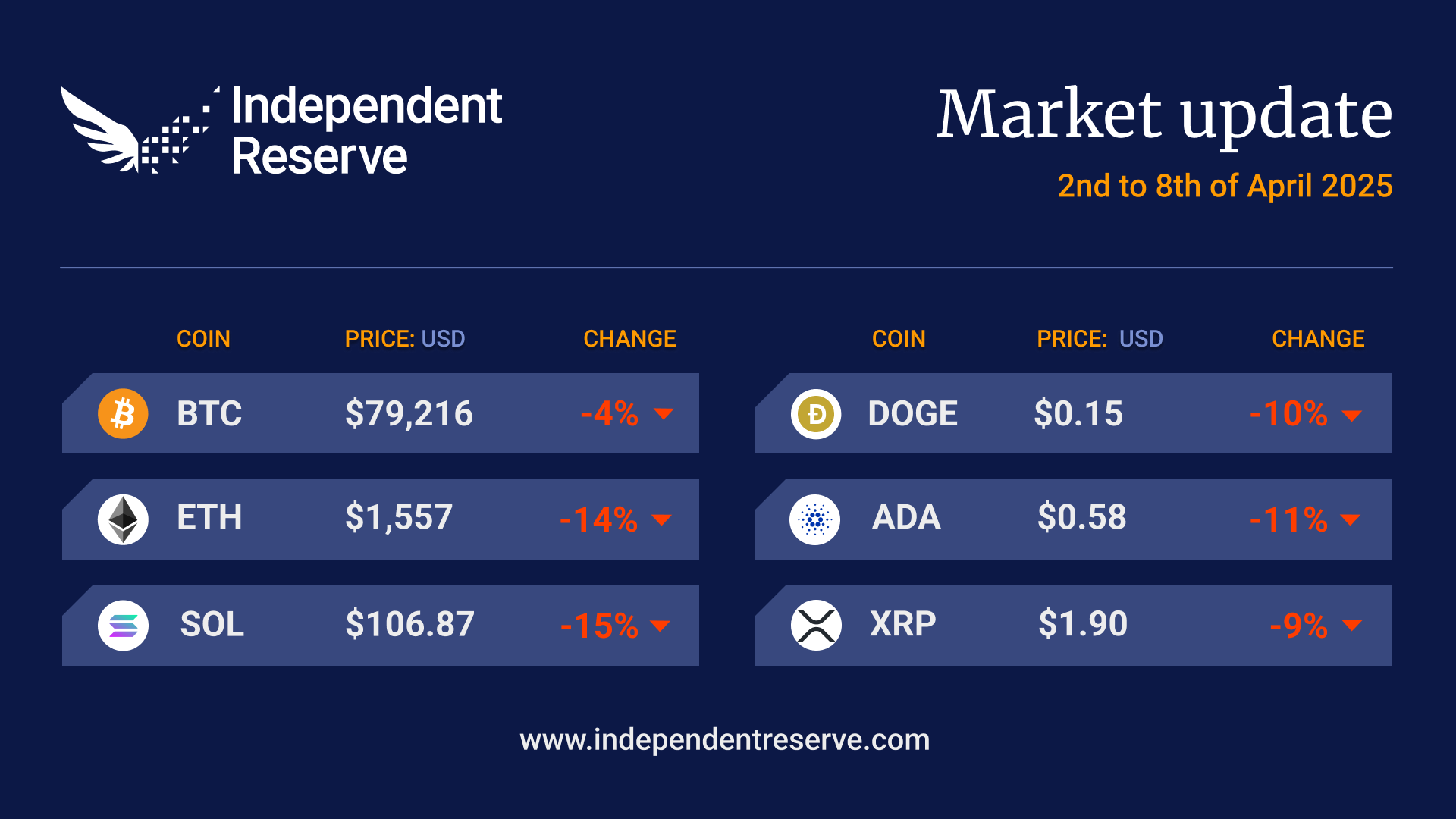In Markets
Crypto markets took a dive following a mixed jobs report in the US which showed employers had added 142,000 new jobs in August – 18,000 less than forecast. Despite the unemployment rate falling to 4.2%, it added to concerns the US still might go into recession. But Treasury Secretary Janet Yellen then popped up to argue the economy was “deep into a recovery.” US stocks bounced back from the dip, and Bitcoin gained 5% overnight. However, BTC still finishes the week down 2% on seven days ago to trade around A$85,756 (US$57,304). Ethereum is down 6% to trade around A$3,531 (US$2,336). Solana was flat despite falling transactions and TVL, XRP lost 4% but Cardano rose 4%. Dogecoin gained 4.6%, possibly because Elon Musk has been tapped by Trump to head up a government waste task force and has been posting memes about the Department Of Government Efficiency (DOGE). After dipping into Extreme Fear, the Crypto Fear and Greed Index is at 33, or Fear. If you take a long-term view the picture remains rosy according to MicroStrategy’s Michael Saylor who tips Bitcoin is headed to A$19.5M (US$13M).

From the IR OTC Desk
The cryptocurrency market has remained rudderless this week. Further direction is needed before the September 19th (AEST) Federal Open Market Committee (FOMC) meeting as well as the 5th of November US Presidential Election – which remains finely balanced. Without a specific market catalyst, which confirms an outcome for one or both of these events, the directionless status appears to remain. It is not only cryptocurrencies which have exhibited ‘rate cut anxiety’. Global technology stocks have been notably volatile too, while fixed income markets remain relatively well anchored in their expectations for the FOMC announcement. There remains a 70% chance of a 25bp reduction to the federal funds rate, and a 30% chance of a 50bp reduction. We all know what the market would like to see! Last week we introduced the term ‘FX war’ to this publication, defining the term as the active agenda of a Central Bank to facilitate the depreciation of their currency through monetary and quantitative policy. And while it is important to recognise that an FX war will most likely eventuate during a rate cutting cycle if aggregate demand remains benign, the timing may be quite some time forward. It is important to keep watch for this event early, however. When it begins, an active M2 debasement usually follows. In the economic calendar, we receive the US inflation report for August as well as Australian consumer inflation expectations for September. In line with the most recent rhetoric from US FOMC Chair Jerome Powell, inflation data is no longer the primary mandate. In this rudderless environment however, inflation data will still prove critical. In the Australia (AEST)
- Wednesday 11:00am AU Consumer Inflation Expectations (Sep)
In the US (AEST)
- Wednesday 10:30pm US Inflation (August)
In China (AEST)
- Saturday 12:00pm CN Retail Sales/IP/Employment (August)
In Singapore (AEST)
- Friday 12:00pm SG Unemployment Rate Final Q2
On the OTC desk, trade volumes have remained high, while notional volumes have reduced. This tends to be the case when the market is uncommitted. For the time being, relative value trading has been more opportunistic – there remains an interrelated investment relationship between BTC, ETH and SOL. With the investible cryptocurrency ETFs becoming the core link between cryptocurrencies and tradfi, it remains important to monitor ETF inflows/outflows. For any further information, please feel free to reach out.
In Headlines
Crypto election #1
Bernstein, a firm managing US$725 billion (A$1.1B) in assets, predicts that Bitcoin could soar to US$90,000 (A$135K) if Republican Donald Trump wins the Presidential election in November. However, if Democrat Kamala Harris wins, Bitcoin might fall to US$30K to US$40K (A$45K to $60K) due to uncertainty over the Democrat’s crypto policies. Polls show the two are neck and neck for the popular vote, but pollster Nate Silver’s models show that Trump has a slight edge in winning the electoral college.
Crypto election #2
Kamala Harris’s newly unveiled campaign platform made no mention of crypto. “For those of us in crypto – this is our reset. We’re at neutral,” argued CEHV’s Adam Cochran. Democrat Senate Majority leader Chuck Schumer also left out any mention of pushing for crypto legislation in this week’s ‘Dear Colleague” letter. Bankless said the absence of any crypto mention “suggests the whispers of the Democratic Party’s reevaluation of crypto was likely a brief reaction to Trump’s momentum around Bitcoin Nashville.” On Monday MicroStrategy’s Michael Saylor told CNBC: “At this point the Republicans have shifted to way progressive and the Democrats are drifting to the middle […] in terms of their view toward crypto and bitcoin,” he added. Congress is holding its first hearing into DeFi today.
Crypto election #3
Bloomberg reports that major Democratic donors are pushing to have Federal Trade Commission chair Lina Khan and SEC boss Gary Gensler replaced if Kamala Harris wins. Billionaire Mark Cuban told CNBC that he’s asked the vice president’s team to “put my name in for the SEC.”
Trump DeFi platform raises eyebrows
The Trump dynasty’s World Liberty Financial product has a codebase largely copied from Dough Finance, a project that was exploited for US$2M (A$3M) in July via a flash loan attack. However, the open source project will feed funds into DeFi lending protocol Aave. A Telegram group for the project now has 212,000 members.
Bitcoin ETFs losing funds fast
Money has been flowing out of the Bitcoin ETFs, with US$706.1M (A$1B) in net outflows last week. The Bitcoin ETFs now hold a total of US$46B (A$69B), the lowest cumulative value since May. On the upside, data shows BlackRock’s ETF has attracted US$1.5B (A$2.25B) from investment advisors. Bitwise Invest CIO Matt Houghan says they are “adopting Bitcoin ETFs faster than any new ETF in history.” The new Ether ETFs saw less than US$10M (A$15M) inflows, but Grayscale lost another US$111M (A$167M). The ETH ETFs have lost 41% of the US$10.24B (A$15.6B) in ETH they held on the first day of trading. VanEck is shuttering its Ether Futures ETF as its spot ETH ETF has already taken three times as many inflows.
FTX creditors could get repaid by year’s end
Unlike Mt Gox creditors who had to wait a decade, FTX customers may get their repayments before the end of the year. There’s US$16B (A$24B) to share around, with customers getting paid back the value of their crypto holdings from November 2022. Incredibly, when FTX entered bankruptcy, it reportedly held just 0.1% of the Bitcoin, and 1.2% of the Ether that customers saw in their balances. Omnibus hearings on the creditor repayment plan are scheduled for October 22, November 20, and December 12 – and if the plan is confirmed at the first hearing Protos reports payments could go out by year’s end. On the subject of Mt Gox, its former owner, Mark Karpeles, is starting a new exchange called EllipX with former Mt Gox users offered a 50% trading fee discount.
Ripple gets smart, launches stablecoin
Ripple is adding Ethereum compatible smart contracts via a sidechain to the XRP ledger, which will expand its capacity into DeFi. Wrapped XRP (eXRP) will be the primary token on the sidechain, and users can bridge in via Axelar from 55 other blockchains. Ripple is also launching the Ripple USD stablecoin in Japan soon, and in the US when regulators give it the nod.
Crypto investors lose $5.6B
The FBI reports that crypto investors lost a record US$5.6 billion (A$8.4B) to scams and cybercrime in 2023, a 45% increase from year before. While just 10% of the 69,000 reports the FBI Internet Crime Complaint Center received last year were crypto crimes, they comprised around 50% of the total USD value of losses. The most prominent scam was “pig butchering” – gaining someone’s confidence over a long period before encouraging them to invest large amounts in scams.
Uptober and Upvember coming
September is traditionally a terrible month for crypto markets and a known phenomenon in traditional markets for almost a century. The S&P500 has declined on average 55% of the time over the past 94 years, and no other month has declined even 50% of the time. It’s unclear why, but summer vacations and firms resetting priorities for the final quarter of the year are thought to be partly responsible. It’s Bitcoin’s worst month on average over the past decade, during which time BTC has declined eight times during the month. But October averages a 22% gain, and November averages a 46% jump. “You just need to survive September,” wrote analyst RektCapital. Until next week, happy trading!


